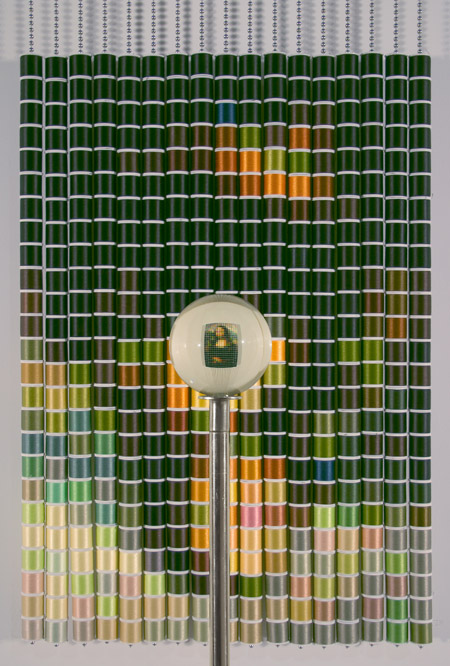at the Brooklyn Museum
January 26- May 6, 2007 (exhibition extended through June 17)
The Eye of the Artist: The Work of Devorah Sperber
The Brooklyn Museum, Brooklyn, New York
A feast of thought-provoking and eye-engaging art awaits visitors to the Brooklyn Museum, where New york artist Devorah Sperber is currently exhibiting five of her thread spool installations and two recent works composed of colored crystals. Fascinated by the connections between art, science, and technology, sperber deconstructs familiar images to address the way we think we see versus the way the brain processes visual information. "As a visual artist," Sperber explains, "I cannot think of a topic more stimulating and yet so basic as the act of seeing-- how the human brain makes sense of the visual world."

Devorah Sperber, After The Mona Lisa 1 (detail), 2005. Spools of thread, aluminum ball chain, hanging apparatus, acrylic viewing sphere and metal stand. Image courtesy of the artist.
The Artist's unique process begins with reproducing images as computer-generated, pixilated diagrams; she then substitutes colored spools of thread for the pixels to recreate historical masterpieces as life-sized installations. The artist hangs the thread spool works upside down, a reference to the way the human eye inverts images onto the retina. From a few feet away, the compositions appear to be merely fields of color; however, once viewed with a viewing sphere that functions like the lens of the eye, each work becomes a clear reproduction of a famous painting.

Included in the Brooklyn Museum exhibition are full-scale recreations of Leonardo da Vinci's Mona Lisa and The Last Supper, as well as Pablo Picasso's Gertrude Stein and Jan van Eyck'ts Man in a Red Turban.
"The original mural is highly symmetrical with the right eye of the Christ figure as the single vanishing point from which all compositional elements project," says Sperber about After The Last Supper, an optical replication of da Vinci's similarly-titled work. "In my rendering, the vanishing point-- which is also Christ's right eye-- is slighly lower than eye level. Because the sphere rotates the imagery 180 degrees, viewers have the illusion of looking up at the image, replicating the orientation of viewers to the original mural."
In her two recent crystal works, Sperber addresses the *well-know phenomenon that, throughout the history of Western portraiture, one eye of the sitter is often located close to the vertical center of the composition. Sperber divides the original portrait along the central vertical axis and then mirrors the two remaining portions so that there are four portraits exhibited in the installation. To see the original portrait emerge,viewers are encouranged to step back an use a piece of paper to block out the two middle sections.
- John McCarthy
* Artist's Note:: Eye-centering in 3/4 view portrature is not a well-known phenomenon.